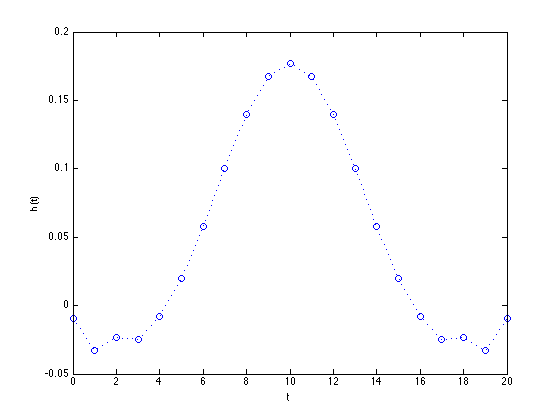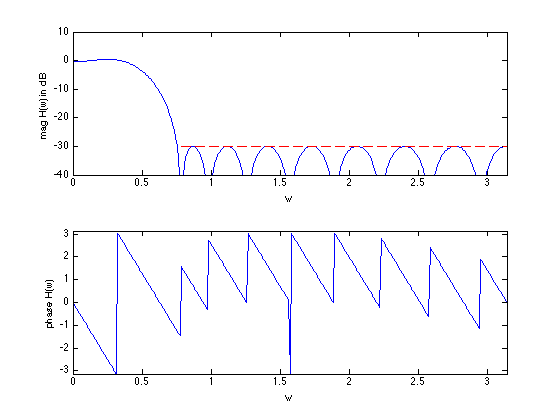n = 10;
wpass = 0.12*pi;
wstop = 0.24*pi;
atten_level = -30;
N = 30*n+1;
w = linspace(0,pi,N);
A = [ones(N,1) 2*cos(kron(w',[1:n]))];
ind = find((0 <= w) & (w <= wpass));
Ap = A(ind,:);
ind = find((wstop <= w) & (w <= pi));
Us = 10^(atten_level/20)*ones(length(ind),1);
As = A(ind,:);
cvx_begin
variable delta
variable h(n+1,1);
minimize( delta )
subject to
Ap*h <= delta;
inv_pos(Ap*h) <= delta;
abs( As*h ) <= Us;
cvx_end
disp(['Problem is ' cvx_status])
if ~strfind(cvx_status,'Solved')
return
else
h = [flipud(h(2:end)); h];
fprintf(1,'The optimal minimum passband ripple is %4.3f dB.\n\n',...
20*log10(delta));
end
figure(1)
plot([0:2*n],h','o',[0:2*n],h','b:')
xlabel('t'), ylabel('h(t)')
figure(2)
H = exp(-j*kron(w',[0:2*n]))*h;
subplot(2,1,1)
plot(w,20*log10(abs(H)),[wstop pi],[atten_level atten_level],'r--');
axis([0,pi,-40,10])
xlabel('w'), ylabel('mag H(w) in dB')
subplot(2,1,2)
plot(w,angle(H))
axis([0,pi,-pi,pi])
xlabel('w'), ylabel('phase H(w)')
Calling SDPT3: 872 variables, 278 equality constraints
For improved efficiency, SDPT3 is solving the dual problem.
------------------------------------------------------------
num. of constraints = 278
dim. of sdp var = 74, num. of sdp blk = 37
dim. of socp var = 458, num. of socp blk = 229
dim. of linear var = 303
*******************************************************************
SDPT3: Infeasible path-following algorithms
*******************************************************************
version predcorr gam expon scale_data
HKM 1 0.000 1 0
it pstep dstep pinfeas dinfeas gap prim-obj dual-obj cputime
-------------------------------------------------------------------
0|0.000|0.000|7.3e+02|4.9e+01|1.1e+05| 2.048238e+01 0.000000e+00| 0:0:00| chol 1 1
1|0.921|0.699|5.8e+01|1.5e+01|2.5e+04| 5.008791e+01 -2.175738e+01| 0:0:00| chol 1 1
2|0.732|0.870|1.6e+01|1.9e+00|4.3e+03| 6.281441e+01 -4.143755e+01| 0:0:00| chol 1 1
3|0.995|0.863|7.8e-02|2.7e-01|5.4e+02| 6.205041e+01 -4.108188e+01| 0:0:00| chol 1 1
4|1.000|0.942|5.0e-04|1.6e-02|7.0e+01| 4.728715e+01 -3.430874e+00| 0:0:00| chol 1 1
5|0.368|1.000|3.1e-04|1.1e-04|4.3e+01| 3.624702e+01 -6.510807e+00| 0:0:00| chol 1 1
6|1.000|0.921|1.5e-05|7.2e-05|6.5e+00| 3.973191e+00 -2.473693e+00| 0:0:00| chol 1 1
7|0.916|0.900|1.4e-06|1.0e-05|2.8e+00| 1.071821e+00 -1.754710e+00| 0:0:00| chol 1 1
8|0.820|0.946|2.6e-07|8.4e-07|1.0e+00|-1.829241e-01 -1.179210e+00| 0:0:00| chol 1 1
9|1.000|1.000|1.6e-09|5.4e-08|3.8e-01|-7.085424e-01 -1.089012e+00| 0:0:00| chol 1 1
10|0.718|0.879|4.5e-10|6.9e-09|1.4e-01|-9.217470e-01 -1.059581e+00| 0:0:00| chol 1 1
11|0.958|0.914|1.9e-11|7.0e-10|1.9e-02|-1.034838e+00 -1.054108e+00| 0:0:00| chol 1 1
12|0.819|0.737|3.5e-12|1.9e-10|7.8e-03|-1.044891e+00 -1.052643e+00| 0:0:00| chol 1 1
13|0.795|0.928|7.0e-13|1.5e-11|3.0e-03|-1.048933e+00 -1.051939e+00| 0:0:00| chol 1 1
14|0.662|0.907|4.3e-13|2.4e-12|1.5e-03|-1.050281e+00 -1.051737e+00| 0:0:00| chol 1 1
15|0.711|0.932|2.0e-12|1.2e-12|6.4e-04|-1.050991e+00 -1.051632e+00| 0:0:00| chol 1 1
16|0.787|0.942|6.7e-12|1.1e-12|2.3e-04|-1.051364e+00 -1.051591e+00| 0:0:00| chol 1 1
17|0.929|0.860|1.7e-12|1.5e-12|3.9e-05|-1.051542e+00 -1.051581e+00| 0:0:00| chol 1 1
18|0.910|0.810|3.4e-12|1.3e-12|5.9e-06|-1.051573e+00 -1.051579e+00| 0:0:00| chol 1 1
19|0.897|0.865|2.3e-12|1.2e-12|8.9e-07|-1.051577e+00 -1.051578e+00| 0:0:00| chol 1 1
20|0.945|0.969|7.3e-13|1.0e-12|7.6e-08|-1.051578e+00 -1.051578e+00| 0:0:01| chol 1 1
21|0.725|1.000|8.1e-13|1.0e-12|3.9e-08|-1.051578e+00 -1.051578e+00| 0:0:01|
stop: max(relative gap, infeasibilities) < 1.49e-08
-------------------------------------------------------------------
number of iterations = 21
primal objective value = -1.05157797e+00
dual objective value = -1.05157801e+00
gap := trace(XZ) = 3.93e-08
relative gap = 1.27e-08
actual relative gap = 1.27e-08
rel. primal infeas = 8.12e-13
rel. dual infeas = 1.00e-12
norm(X), norm(y), norm(Z) = 1.2e+00, 1.1e+00, 1.2e+01
norm(A), norm(b), norm(C) = 8.6e+01, 2.0e+00, 9.6e+00
Total CPU time (secs) = 0.55
CPU time per iteration = 0.03
termination code = 0
DIMACS: 8.1e-13 0.0e+00 4.8e-12 0.0e+00 1.3e-08 1.3e-08
-------------------------------------------------------------------
------------------------------------------------------------
Status: Solved
Optimal value (cvx_optval): +1.05158
Problem is Solved
The optimal minimum passband ripple is 0.437 dB.



